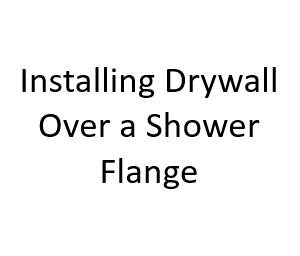As homeowners embark on various home improvement projects, one area that often requires attention is the bathroom. Whether you’re renovating or building a new bathroom, the intricacies of the process can sometimes be overwhelming. One common challenge many DIY enthusiasts encounter is how to properly install drywall over a shower flange. This critical step ensures a watertight and visually appealing finish, preventing moisture damage and mold growth. In this blog post, we’ll delve into the details of Installing drywall over a shower flange, offering a comprehensive guide to help you achieve professional results.
Understanding the Importance of a Shower Flange:
Before we dive into the installation process, let’s first understand the role of a shower flange. A shower flange is a critical component that connects the shower drain to the plumbing system. It creates a secure seal to prevent water from leaking into the subfloor and surrounding areas. While the primary function of a shower flange is to ensure proper drainage, it also plays a crucial role in supporting the shower base or pan and providing a stable surface for tiling or other wall coverings.
Materials You’ll Need:
Before you begin the installation process, gather the necessary materials:
- Drywall sheets (moisture-resistant is recommended)
- Utility knife
- Screwdriver
- Screws (appropriate for attaching drywall to studs)
- Measuring tape
- Pencil
- Joint compound
- Drywall tape
- Sandpaper
- Primer and paint (moisture-resistant)
Step-by-Step Installation Guide:
1. Preparation: Begin by carefully measuring the dimensions of the area around the shower flange. Mark the location of the shower flange on the drywall sheet using a pencil. Ensure that you leave enough space for the flange to fit comfortably within the marked area.
2. Cutting the Drywall: Using a utility knife, cut the drywall sheet along the marked lines. Make precise cuts to ensure a snug fit around the shower flange. Remember that accuracy is essential to maintain the integrity of the installation.
3. Attaching the Drywall: Position the cut drywall sheet over the shower flange area and secure it to the studs using screws. Ensure that the screws are evenly spaced and driven in flush with the drywall surface. This step provides the foundation for the rest of the installation.
4. Applying Joint Compound and Tape: To create a seamless surface, apply a thin layer of joint compound around the edges of the drywall and over the screw heads. Place drywall tape over the joints and press it into the compound. Apply another layer of joint compound over the tape, feathering the edges to create a smooth transition between the drywall and the surrounding area. Allow the compound to dry completely before moving on to the next step.
5. Sanding and Finishing: Once the joint compound is dry, use sandpaper to smooth any uneven areas or excess compound. This step is crucial for achieving a polished finish that’s ready for painting.
6. Priming and Painting: Apply a coat of moisture-resistant primer to the drywall to create a barrier against moisture infiltration. After the primer dries, paint the area with a high-quality moisture-resistant paint. This not only enhances the aesthetic appeal but also provides additional protection against humidity and water exposure.
7. Final Inspection: Carefully inspect the finished installation to ensure that the drywall is securely attached, the joint compound is smooth, and the paint is evenly applied. Address any imperfections before considering the project complete.
Common Challenges and Troubleshooting:
While the steps outlined above provide a solid foundation for installing drywall over a shower flange, you may encounter some challenges along the way. Here are some common issues and troubleshooting tips:
1. Gaps and Uneven Surfaces: If you notice gaps or uneven surfaces after installing the drywall, you can use additional joint compound to fill in these areas. Apply thin layers and sand between coats for a smooth finish.
2. Mold and Moisture Resistance: To further enhance moisture resistance, consider using moisture-resistant drywall (often referred to as green board or cement board) instead of regular drywall. This type of drywall is specifically designed for high-humidity areas like bathrooms and offers better protection against mold and moisture damage.
3. Protecting the Shower Flange: While installing the drywall, be cautious not to damage the shower flange. If you accidentally puncture it or create a gap, you can use silicone caulk or a waterproof sealant to ensure a watertight seal.
4. Tiling Over Drywall: If you plan to tile over the drywall, it’s essential to use a waterproof tile backer board or apply a waterproofing membrane to the drywall surface before tiling. This added layer of protection prevents water from seeping through the grout and damaging the drywall.
5. Maintenance and Regular Inspections: Once the drywall is in place and painted, it’s crucial to perform regular maintenance and inspections. Check for any signs of water damage, such as peeling paint or soft spots, and address them promptly to prevent more extensive issues.
Final Thoughts:
Installing drywall over a shower flange is a crucial step in creating a functional and visually pleasing bathroom. By following the steps outlined in this comprehensive guide and addressing common challenges, you can ensure a successful installation that protects your home from water damage and provides a beautiful finish.
Remember that if you’re unsure about any part of the process, it’s always a good idea to consult with a professional contractor or experienced DIY enthusiast. Their expertise can be invaluable in achieving the best results and ensuring the long-term durability of your bathroom walls.
In conclusion, a well-executed drywall installation over a shower flange not only enhances the functionality of your bathroom but also adds to its overall appeal. With the right materials, techniques, and attention to detail, you can enjoy a beautiful and watertight bathroom for years to come.
